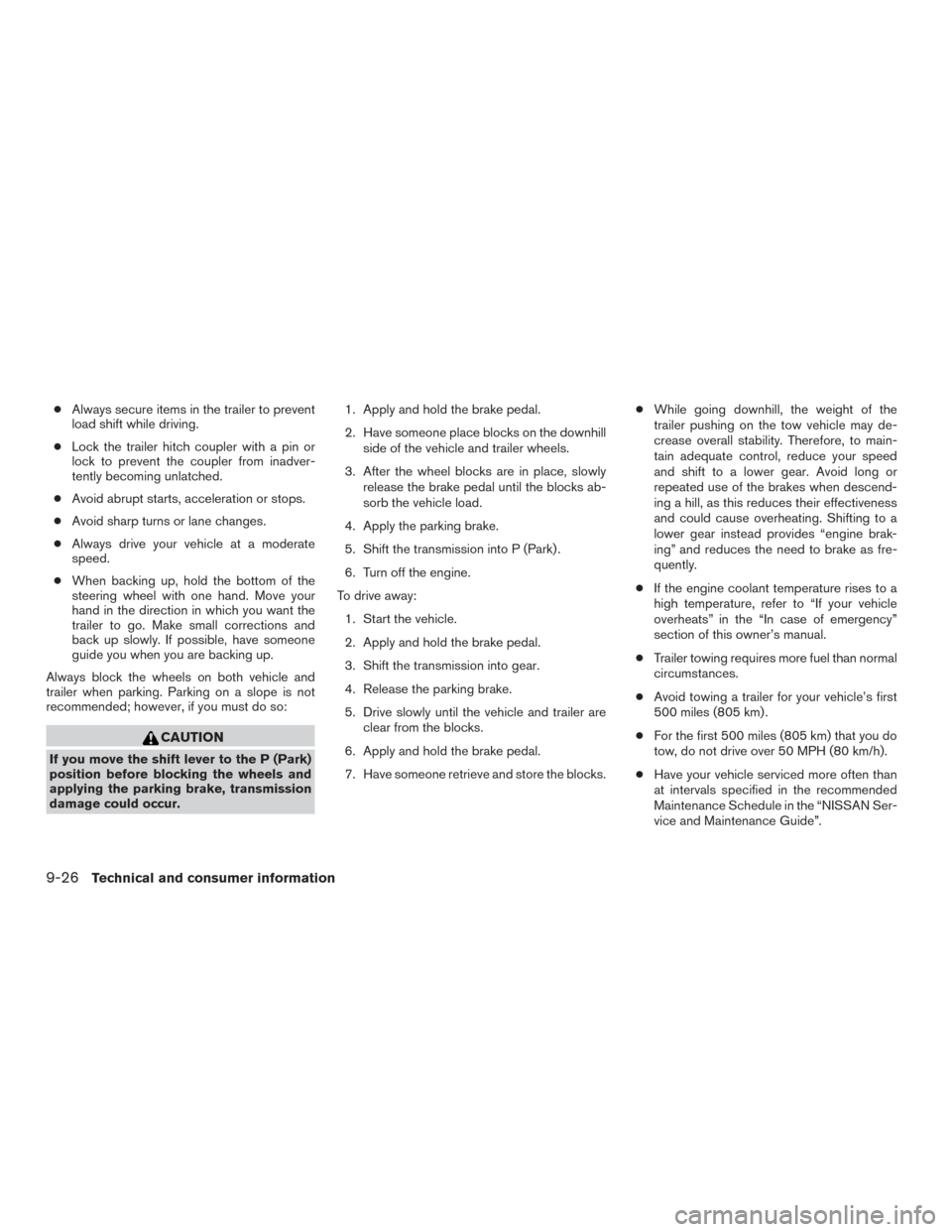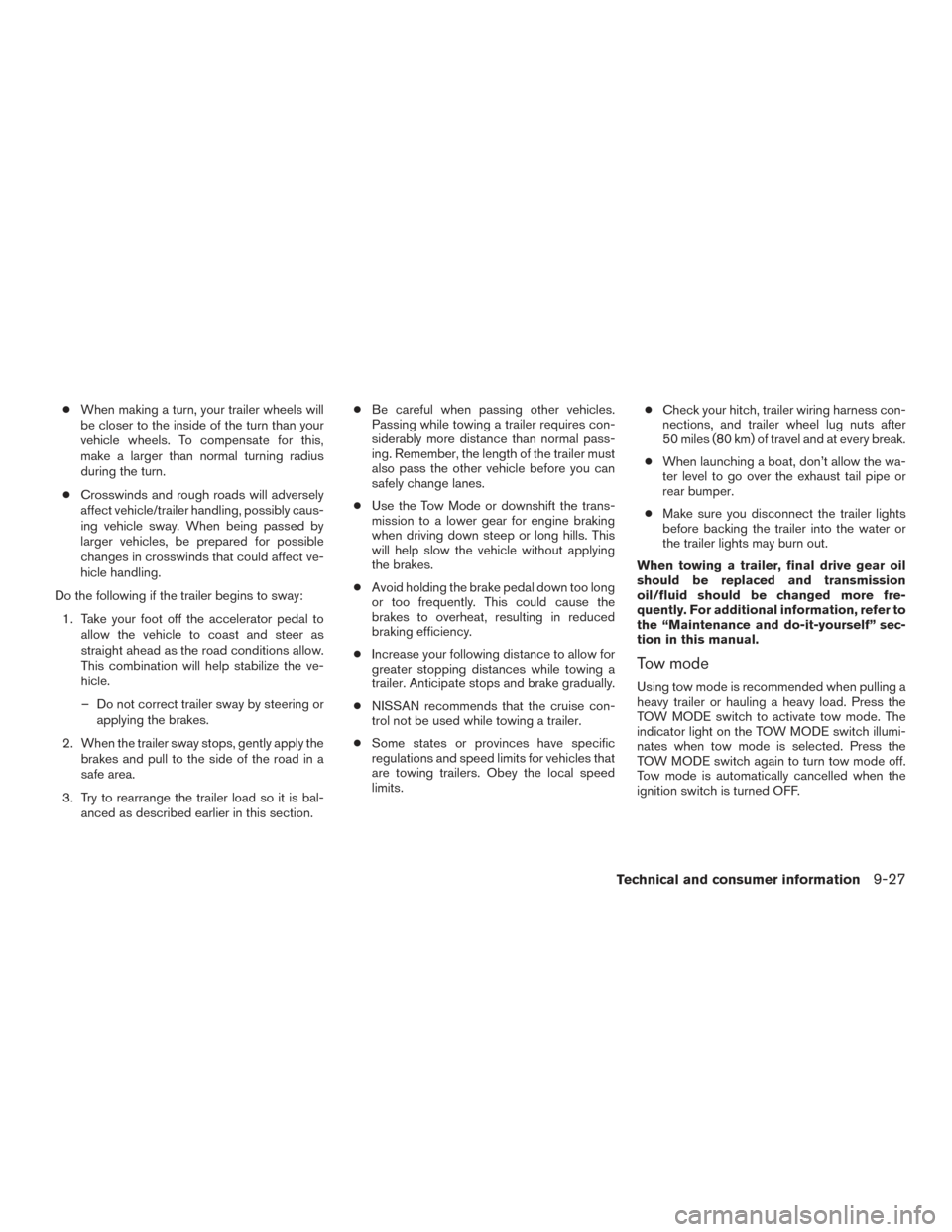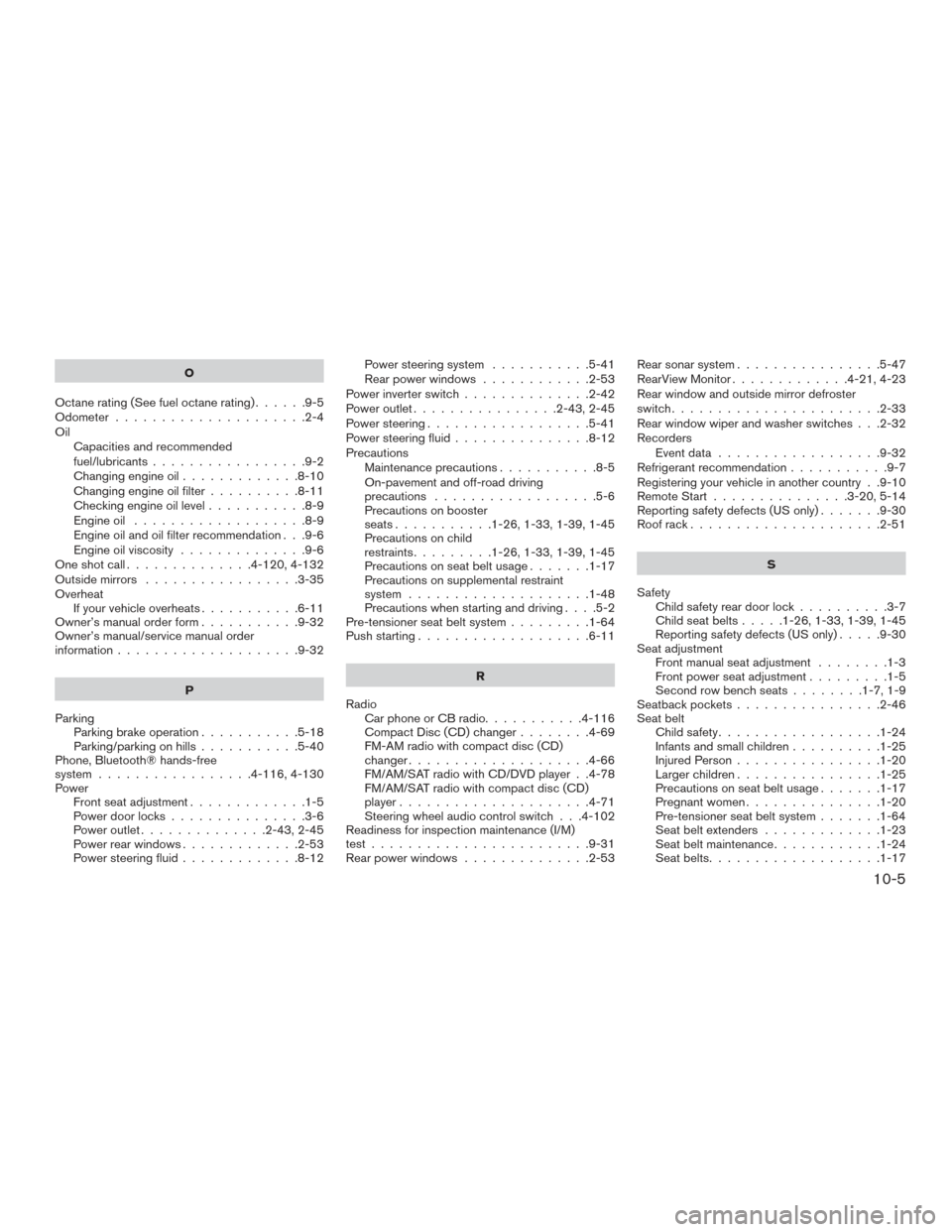2015 NISSAN PATHFINDER engine overheat
[x] Cancel search: engine overheatPage 491 of 506

●Always secure items in the trailer to prevent
load shift while driving.
● Lock the trailer hitch coupler with a pin or
lock to prevent the coupler from inadver-
tently becoming unlatched.
● Avoid abrupt starts, acceleration or stops.
● Avoid sharp turns or lane changes.
● Always drive your vehicle at a moderate
speed.
● When backing up, hold the bottom of the
steering wheel with one hand. Move your
hand in the direction in which you want the
trailer to go. Make small corrections and
back up slowly. If possible, have someone
guide you when you are backing up.
Always block the wheels on both vehicle and
trailer when parking. Parking on a slope is not
recommended; however, if you must do so:
CAUTION
If you move the shift lever to the P (Park)
position before blocking the wheels and
applying the parking brake, transmission
damage could occur. 1. Apply and hold the brake pedal.
2. Have someone place blocks on the downhill
side of the vehicle and trailer wheels.
3. After the wheel blocks are in place, slowly release the brake pedal until the blocks ab-
sorb the vehicle load.
4. Apply the parking brake.
5. Shift the transmission into P (Park) .
6. Turn off the engine.
To drive away: 1. Start the vehicle.
2. Apply and hold the brake pedal.
3. Shift the transmission into gear.
4. Release the parking brake.
5. Drive slowly until the vehicle and trailer are clear from the blocks.
6. Apply and hold the brake pedal.
7. Have someone retrieve and store the blocks. ●
While going downhill, the weight of the
trailer pushing on the tow vehicle may de-
crease overall stability. Therefore, to main-
tain adequate control, reduce your speed
and shift to a lower gear. Avoid long or
repeated use of the brakes when descend-
ing a hill, as this reduces their effectiveness
and could cause overheating. Shifting to a
lower gear instead provides “engine brak-
ing” and reduces the need to brake as fre-
quently.
● If the engine coolant temperature rises to a
high temperature, refer to “If your vehicle
overheats” in the “In case of emergency”
section of this owner’s manual.
● Trailer towing requires more fuel than normal
circumstances.
● Avoid towing a trailer for your vehicle’s first
500 miles (805 km) .
● For the first 500 miles (805 km) that you do
tow, do not drive over 50 MPH (80 km/h).
● Have your vehicle serviced more often than
at intervals specified in the recommended
Maintenance Schedule in the “NISSAN Ser-
vice and Maintenance Guide”.
9-26Technical and consumer information
Page 492 of 506

●When making a turn, your trailer wheels will
be closer to the inside of the turn than your
vehicle wheels. To compensate for this,
make a larger than normal turning radius
during the turn.
● Crosswinds and rough roads will adversely
affect vehicle/trailer handling, possibly caus-
ing vehicle sway. When being passed by
larger vehicles, be prepared for possible
changes in crosswinds that could affect ve-
hicle handling.
Do the following if the trailer begins to sway: 1. Take your foot off the accelerator pedal to allow the vehicle to coast and steer as
straight ahead as the road conditions allow.
This combination will help stabilize the ve-
hicle.
– Do not correct trailer sway by steering or applying the brakes.
2. When the trailer sway stops, gently apply the brakes and pull to the side of the road in a
safe area.
3. Try to rearrange the trailer load so it is bal- anced as described earlier in this section. ●
Be careful when passing other vehicles.
Passing while towing a trailer requires con-
siderably more distance than normal pass-
ing. Remember, the length of the trailer must
also pass the other vehicle before you can
safely change lanes.
● Use the Tow Mode or downshift the trans-
mission to a lower gear for engine braking
when driving down steep or long hills. This
will help slow the vehicle without applying
the brakes.
● Avoid holding the brake pedal down too long
or too frequently. This could cause the
brakes to overheat, resulting in reduced
braking efficiency.
● Increase your following distance to allow for
greater stopping distances while towing a
trailer. Anticipate stops and brake gradually.
● NISSAN recommends that the cruise con-
trol not be used while towing a trailer.
● Some states or provinces have specific
regulations and speed limits for vehicles that
are towing trailers. Obey the local speed
limits. ●
Check your hitch, trailer wiring harness con-
nections, and trailer wheel lug nuts after
50 miles (80 km) of travel and at every break.
● When launching a boat, don’t allow the wa-
ter level to go over the exhaust tail pipe or
rear bumper.
● Make sure you disconnect the trailer lights
before backing the trailer into the water or
the trailer lights may burn out.
When towing a trailer, final drive gear oil
should be replaced and transmission
oil/fluid should be changed more fre-
quently. For additional information, refer to
the “Maintenance and do-it-yourself” sec-
tion in this manual.
Tow mode
Using tow mode is recommended when pulling a
heavy trailer or hauling a heavy load. Press the
TOW MODE switch to activate tow mode. The
indicator light on the TOW MODE switch illumi-
nates when tow mode is selected. Press the
TOW MODE switch again to turn tow mode off.
Tow mode is automatically cancelled when the
ignition switch is turned OFF.
Technical and consumer information9-27
Page 502 of 506

O
Octanerating(Seefueloctanerating)......9-5
Odometer .....................2-4
Oil Capacities and recommended
fuel/lubricants .................9-2
Changing engine oil .............8-10
Changing engine oil filter ..........8-11
Checking engine oil level ...........8-9
Engine oil ...................8-9
Engine oil and oil filter recommendation . . .9-6
Engine oil viscosity ..............9-6
Oneshotcall..............4- 120, 4-132
Outside mirrors .................3-35
Overheat Ifyourvehicleoverheats...........6-11
Owner’s manual order form ...........9-32
Owner’s manual/service manual order
information ....................9-32
P
Parking Parking brake operation ...........5-18
Parking/parking on hills ...........5-40
Phone, Bluetooth® hands-free
system .................4- 116, 4-130
Power Front seat adjustment .............1-5
Power door locks ...............3-6
Power outlet ..............2-43,2-45
Power rear windows .............2-53
Power steering fluid .............8-12 Power steering system
...........5-41
Rear power windows ............2-53
Power inverter switch ..............2-42
Power outlet ................2-43,2-45
Power steering ..................5-41
Power steering fluid ...............8-12
Precautions Maintenance precautions ...........8-5
On-pavement and off-road driving
precautions ..................5-6
Precautions on booster
seats...........1-26,1-33,1-39,1-45
Precautions on child
restraints .........1-26,1-33,1-39,1-45
Precautions on seat belt usage .......1-17
Precautions on supplemental restraint
system ....................1-48
Precautions when starting and driving ....5-2
Pre-tensioner seat belt system .........1-64
Push starting ...................6-11
R
Radio Car phone or CB radio ...........4-116
Compact Disc (CD) changer ........4-69
FM-AM radio with compact disc (CD)
changer ....................4-66
FM/AM/SAT radio with CD/DVD player . .4-78
FM/AM/SAT radio with compact disc (CD)
player .....................4-71
Steering wheel audio control switch . . .4-102
Readiness for inspection maintenance (I/M)
test........................9-31
Rear power windows ..............2-53 Rear sonar system
................5-47
RearView Monitor .............4-21,4-23
Rear window and outside mirror defroster
switch.......................2-33
Rear window wiper and washer switches . . .2-32
Recorders Eventdata..................9-32
Refrigerant recommendation ...........9-7
Registering your vehicle in another country . .9-10
Remote Start ...............
3-20,5-14
Reporting safety defects (US only) .......9-30
Roof rack .....................2-51
S
Safety Child safety rear door lock ..........3-7
Child seat belts .....1-26,1-33,1-39,1-45
Reporting safety defects (US only) .....9-30
Seat adjustment Front manual seat adjustment ........1-3
Front power seat adjustment .........1-5
Secondrowbenchseats........1-7,1-9
Seatbackpockets................2-46
Seat belt Child safety ..................1-24
Infants and small children ..........1-25
Injured Person ................1-20
Largerchildren................1-25
Precautions on seat belt usage .......1-17
Pregnant women ...............1-20
Pre-tensioner seat belt system .......1-64
Seatbeltextenders .............1-23
Seatbeltmaintenance............1-24
Seatbelts...................1-17
10-5